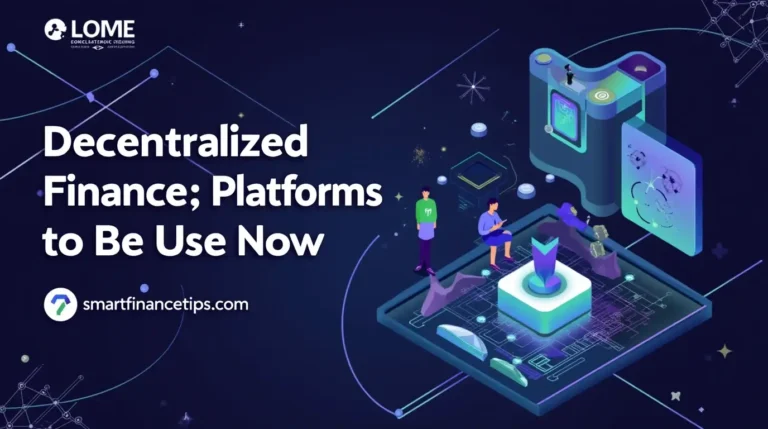The Best Fluffy Pancakes recipe you will fall in love with. Full of tips and tricks to help you make the best pancakes.
Table of Contents
Introduction to Decentralized Finance

decentralized finance companies
Decentralized finance, commonly referred to as DeFi, represents a transformative approach to financial transactions that leverages innovative technologies to eliminate the need for traditional intermediaries, such as banks and financial institutions. By utilizing blockchain technology, DeFi enables the creation of a transparent, secure, and open financial system, allowing users to engage in various financial activities directly with one another. learn about : how many business days in a year;
At its core, DeFi operates on smart contracts, which are self-executing contracts with the terms of the agreement directly written into code. These contracts automate the execution of transactions and eliminate the potential for human error, fraud, or manipulation, enhancing the reliability of financial operations. This automation not only increases efficiency but also significantly reduces transaction fees compared to conventional financial services.
The significance of DeFi in today’s financial ecosystem is underscored by its explosive growth in recent years. The rise in popularity of cryptocurrencies has played a pivotal role in this development, as digital assets form the basis of numerous DeFi applications. Bitcoin, Ethereum, and various altcoins serve as the underlying assets for many DeFi platforms, facilitating a myriad of services such as lending, borrowing, and trading without the necessity of a central authority.
Moreover, DeFi is fostering financial inclusion by providing access to services for individuals who may be underserved or excluded from traditional banking systems. Users from different geographical locations can participate in DeFi through the use of wallets and mobile devices, thereby circumventing barriers like geographical restrictions and stringent regulatory hurdles.
In summary, decentralized finance presents a revolutionary shift in the financial landscape, driven by blockchain technology, smart contracts, and cryptocurrencies. As this sector continues to evolve, it offers new opportunities for innovation and accessibility across the global financial system.
The Evolution of Finance: From Traditional to Decentralized
The landscape of finance has undergone dramatic transformations throughout history, evolving from primitive bartering systems to sophisticated financial institutions that govern global economic interactions. Traditional financial systems are often characterized by centralized control, where banks and financial authorities manage transactions, set interest rates, and enforce regulatory compliance. While these institutions have provided stability and reliability, they have also faced criticism for their lack of transparency, inefficiencies, and significant reliance on intermediaries. The traditional model often results in high costs and slow processing times, particularly in cross-border transactions.
The limitations of centralized systems became increasingly apparent, inspiring innovators and technologists to seek alternatives. This quest for a more inclusive and equitable financial system was propelled by the launch of Bitcoin in 2009. By introducing a decentralized peer-to-peer network secured by cryptographic techniques, Bitcoin challenged the fundamental principles of traditional finance. It emphasized self-custody, anonymity, and the removal of intermediaries, thus laying the groundwork for what would later develop into a more comprehensive Decentralized Finance (DeFi) ecosystem.
Building on Bitcoin’s innovative framework, Ethereum, launched in 2015, introduced the concept of smart contracts, allowing developers to create decentralized applications (dApps) on its blockchain. This pivotal moment expanded the possibilities of DeFi, as it facilitated more complex financial instruments and services such as lending, borrowing, and decentralized exchanges without the need for traditional financial intermediaries. Subsequently, early DeFi protocols emerged, such as MakerDAO and Uniswap, which offered users novel ways to engage with financial services directly on the blockchain. These developments marked the beginning of a paradigm shift toward decentralized finance, shaping a new trajectory for financial interactions and the future of global economics.
Key Players in the DeFi Space

The decentralized finance (DeFi) ecosystem is composed of various types of companies, each contributing to the innovative landscape that seeks to disrupt traditional financial systems. Among the most prominent categories are lending platforms, decentralized exchanges (DEXs), yield farming projects, and stablecoin issuers. Each of these sectors plays a crucial role in the development and operation of DeFi, underpinning its appeal to users seeking alternatives to conventional finance.
Lending platforms, such as Compound and Aave, allow users to lend and borrow cryptocurrencies without the need for intermediaries. These platforms utilize smart contracts on the blockchain, which enables users to seamlessly manage their assets. For instance, Compound empowers users to earn interest on their cryptocurrencies by providing liquidity to borrowers while also facilitating loans at competitive rates.
Decentralized exchanges like Uniswap serve a different purpose, enabling users to trade cryptocurrencies directly with one another through automated liquidity pools. Uniswap has become a cornerstone of the DeFi space by allowing users to swap tokens without relying on a centralized authority, thus ensuring greater transparency and security. The platform employs a unique automated market maker (AMM) mechanism, which has revolutionized how transactions occur in the crypto ecosystem.
Yield farming projects provide avenues for maximizing returns on crypto assets by offering rewards for participants who contribute liquidity to various DeFi protocols. Platforms such as Yearn Finance optimize yield farming strategies, allowing users to maximize their returns in an automated fashion. By analyzing and identifying the best opportunities for investing in liquidity pools and lending protocols, these platforms drive further adoption and participation in DeFi.
Lastly, stablecoin issuers like MakerDAO and Tether play integral roles in the DeFi framework. MakerDAO’s DAI stablecoin is pegged to the US dollar, allowing users to conduct transactions with reduced volatility. Such stablecoins facilitate various DeFi transactions, maintaining user confidence and participation across platforms.
How Decentralized Finance Works
Decentralized Finance (DeFi) represents a paradigm shift in the financial industry, enabling the creation of financial services without the reliance on traditional centralized intermediaries. At the heart of DeFi are smart contracts—self-executing contracts with the terms of the agreement directly written into code. This innovative mechanism ensures transparency and trust, as the terms are irrevocable once deployed on a blockchain network, such as Ethereum.
Liquidity pools are another fundamental component of DeFi, providing the necessary liquidity for various financial transactions. These pools consist of assets locked in smart contracts which facilitate trading, lending, and borrowing. Users can contribute their tokens to these pools in exchange for a share of the transaction fees generated, thus incentivizing participation and enhancing liquidity within the market. The decentralized nature of these pools reduces reliance on individual liquidity providers, moving toward a more robust financial ecosystem.
Automated Market Makers (AMMs) further enhance the DeFi framework by allowing users to trade assets directly from their wallets, without the necessity of a centralized exchange. AMMs utilize algorithms to set prices based on supply and demand, effectively allowing users to buy and sell tokens in a permissionless manner. This innovation ensures that trades occur at prevailing market rates while simultaneously providing liquidity for those who are willing to supply it. Consequently, the interconnectedness of smart contracts, liquidity pools, and AMMs establishes a resilient infrastructure for lending, trading, and asset management.
Ultimately, the mechanics of decentralized finance demonstrate how the traditional financial system can be transformed. By capitalizing on blockchain technology, these components challenge conventional processes, paving the way for a more inclusive and accessible financial landscape.
Advantages of Decentralized Finance

Decentralized Finance (DeFi) offers several significant advantages over traditional finance, making it an attractive alternative for users worldwide. One of the most notable benefits is increased accessibility. In contrast to traditional financial services, which often require individuals to meet certain criteria, DeFi platforms enable anyone with an internet connection to access financial services. This democratization of finance provides opportunities for people in marginalized communities or underbanked regions to participate in the global economy.
Lower costs are another compelling advantage of DeFi. Traditional financial institutions often impose high fees for services such as international transfers, lending, and trading. In a decentralized financial ecosystem, middlemen are largely eliminated, which can significantly reduce transaction costs. For instance, users engaging in cryptocurrency swaps can often do so with minimal fees, a stark contrast to the high commission rates charged by brokers or banks.
Furthermore, transparency is enhanced in the DeFi space. Traditional financial systems can be opaque, with transactions often buried in bureaucratic processes. Conversely, DeFi platforms are built on blockchain technology, ensuring that all transactions are recorded in a public ledger. This transparency not only builds trust among users but also allows for accountability and easier auditing of financial activities.
Lastly, DeFi grants users greater control over their assets. Unlike traditional finance, where users must trust third parties to safeguard their funds, DeFi enables individuals to maintain ownership and control of their cryptocurrencies through non-custodial wallets. This empowerment fosters a sense of security and autonomy that many users find appealing. Furthermore, real-world applications such as liquidity pools and decentralized lending platforms illustrate these advantages, showcasing how DeFi is reshaping the financial landscape to the benefit of its users.
Challenges and Risks in the DeFi Space
The decentralized finance (DeFi) ecosystem has garnered significant attention for its potential to revolutionize traditional financial systems; however, it is not without its challenges and risks. One of the foremost concerns in the DeFi landscape is regulatory uncertainty. Governments and financial authorities around the world are still grappling with the implications of decentralized financial systems. The lack of a clear regulatory framework can create an unpredictable environment for users and developers alike, making compliance and legal matters challenging.
Another notable risk is the security vulnerabilities that plague many DeFi platforms. Hacks and exploits pose a significant threat to users’ capital. Since the DeFi space operates on smart contracts and blockchain technology, any flaws or bugs can be exploited by malicious actors, leading to substantial financial losses. High-profile incidents have demonstrated that even well-audited projects are not immune to security breaches, highlighting the need for enhanced security measures and continuous vigilance.
Market volatility is also a major concern within DeFi. The value of assets can fluctuate dramatically in a short period, which may lead to unintended consequences for investors. The volatility of cryptocurrencies often results in rapid price drops, which can severely impact DeFi products that rely on collateralized assets. Such fluctuations create a risky atmosphere for users who may find themselves with insufficient collateral backing their positions, resulting in liquidations and losses.
Users must exercise caution and conduct thorough research prior to engaging with any DeFi product. Understanding the underlying mechanics, staying informed about the latest developments in regulations and security protocols, and recognizing the inherent market risks are essential steps for anyone venturing into decentralized finance. The landscape is rapidly evolving, and so are the associated risks, making it imperative for participants to remain vigilant and well-informed.
Regulatory Landscape for DeFi Companies

The rise of Decentralized Finance (DeFi) has brought forth a unique set of challenges regarding regulatory compliance. As DeFi companies operate on blockchain technology and emphasize decentralization, traditional regulatory frameworks—designed for conventional financial institutions—often struggle to encapsulate these innovative structures. Different countries exhibit diverse approaches to DeFi regulations, reflecting varying levels of willingness to embrace this emerging sector.
In the United States, regulatory bodies like the Securities and Exchange Commission (SEC) have adopted cautious stances, focusing on whether DeFi tokens and services classify as securities under existing laws. This has led many DeFi projects to grapple with compliance measures, risking potential penalties while trying to maintain their decentralized ethos. Similarly, the Commodity Futures Trading Commission (CFTC) has expressed its intent to monitor DeFi platforms that facilitate trading of derivatives, thus expanding scrutiny into another essential area of finance.
Conversely, some countries, such as Switzerland, have established frameworks explicitly designed for blockchain technologies, embracing the DeFi sector with a progressive mindset. The Swiss Financial Market Supervisory Authority (FINMA) has outlined guidelines that allow for innovation while ensuring consumer protection. This more welcoming approach stands in stark contrast to stricter regulations seen in other jurisdictions that may stifle innovation or drive DeFi firms to operate in less regulated environments.
A significant challenge for decentralized finance companies is the inherent tension between the principles of decentralization and the need for regulatory compliance. While many DeFi projects aim to operate autonomously, they must navigate a complex landscape to achieve legitimacy. As global regulatory stances continue to evolve, DeFi companies may need to adapt their strategies, ensuring they can thrive while upholding both their innovative technological frameworks and necessary compliance with applicable laws.
The Future of Decentralized Finance
The decentralized finance (DeFi) landscape is evolving rapidly, and the future promises significant advancements that could reshape the financial ecosystem. One of the key trends expected in the coming years is enhanced interoperability among various DeFi platforms. This integration will facilitate seamless asset transfers and transactions across different blockchain networks, enabling a more cohesive financial system. As various protocols begin to communicate more efficiently, users will benefit from reduced friction and improved accessibility, ultimately expanding the DeFi user base.
Another critical aspect of the DeFi future is the improvement of user experience. Many current DeFi applications possess complex interfaces, often deterring potential users. To truly compete with traditional financial services, DeFi projects will need to prioritize usability. This includes simplifying onboarding processes and improving navigation, thereby catering to both novice users and experienced investors. A more intuitive interface can bridge the gap between DeFi and mainstream finance, promoting wider adoption over time.
Furthermore, the integration of DeFi with traditional finance is poised to become a hallmark of the future landscape. Financial institutions are increasingly exploring ways to harness blockchain technology and DeFi concepts, seeking enhancements in efficiency and cost-effectiveness. Such collaborations may lead to hybrid models that leverage the advantages of both worlds, encouraging institutions to adopt DeFi solutions while maintaining regulatory compliance. This convergence can foster a more resilient economic system, providing services that cater to a broader audience.
Speculatively, the role of DeFi in the global economy may expand significantly, addressing financial inclusion challenges and offering innovative solutions. By democratizing access to financial services, DeFi holds the potential to empower unbanked populations and stimulate economic growth. The future of decentralized finance remains promising, with numerous opportunities for innovation, collaboration, and widespread adoption on the horizon.
Conclusion: The Impact of DeFi on the Financial Landscape

Decentralized Finance (DeFi) represents a significant shift within the traditional financial ecosystem, altering how individuals interact with financial products and services. As we’ve explored throughout this blog post, DeFi leverages blockchain technology to create an open, permissionless, and highly transparent financial environment. This innovation eliminates intermediaries, thus reducing costs and increasing accessibility for users worldwide. The emergence of DeFi platforms facilitates the democratization of financial services, ensuring that anyone with internet access can participate in trading, lending, and borrowing without geographic limitations.
One of the key takeaways is the potential for DeFi to empower users with greater control over their assets. Unlike conventional banking systems, where users have limited agency and visibility, DeFi allows for direct ownership of assets through smart contracts. Furthermore, the ability to earn yield on cryptocurrencies and engage in liquidity provisioning has opened up new avenues for personal finance management and investment strategies. These decentralized applications (dApps) are reshaping notions of ownership, privacy, and financial identity.
With innovation comes risk, and it is essential for participants to remain vigilant about the potential pitfalls associated with decentralized finance. Issues such as smart contract vulnerabilities, regulatory considerations, and market volatility are inherent in this landscape. Therefore, individuals must educate themselves about the DeFi space and its implications for their financial futures. Staying informed about developments in DeFi will enable users to navigate this new terrain with confidence and make informed decisions that align with their financial goals.
In conclusion, DeFi stands as a transformative force in the financial sector, providing unprecedented opportunities for empowerment and innovation. As the ecosystem continues to evolve, the importance of understanding its implications on personal finance and investment will only grow. By embracing this new paradigm, individuals can harness the full potential of decentralized finance to enhance their economic freedom.
Did You Like Our Article
i like this poste you help me
. We encourage readers to take actionable steps towards establishing their emergency fund, making a commitment to their financial future. Doing so is not just a precaution; it is a proactive strategy that lays the groundwork for a secure and stress-free financial life.
ai monetization artificial intelligence behavioral economics blogging guide bubble cryptocurrency budgeting strategies budget management business business days business license business plan business plans cryptocurrency creation debt management debt strategies decentralized finance earn money finance development financial app financial planning fintech services freelance business freelancing business home earnings investment methods investment stocks invest stocks marketing services money blogging money management money online personal budget personal budgeting personal data personal finance real estate remote work side business small business start start business stock investment stock market stock trading successful businesses
decentralized finance companies success you need to know1 now
Decentralized finance, commonly referred to as DeFi, represents a transformative approach to financial transactions that leverages innovative technologies to eliminate the need for traditional intermediaries, such as banks and financial institutions. By utilizing blockchain technology, DeFi enables the creation of a transparent, secure, and open financial system, allowing users to engage in various financial activities directly with one another. learn about : how many business days in a year;








